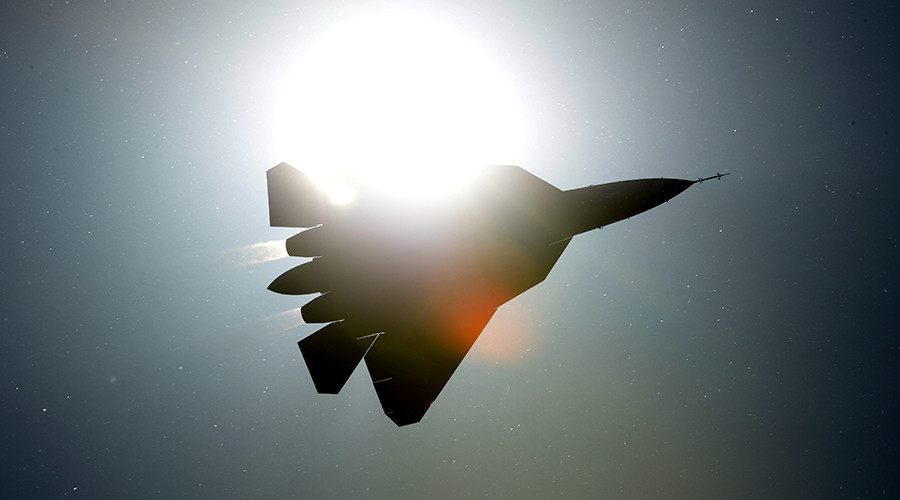
Photo: Sputnik / Alexey Filippov
Russia’s sixth-generation fighter jets will be rounding on the enemy in a so-called “swarm”, mainly consisting of unmanned aircraft flying at hypersonic speed. Developers plan to unveil new jets by 2025, and say that such groups will be able to interact and transit through space.
“The main principle of this aircraft’s way of deployment is a so-called swarm, a collective solving of any task. There will be one or two piloted aircrafts in the group, the others will be unmanned vehicles,” Vladimir Mikheev, an advisor to the deputy head of the Radioelectronic Technologies Concern [KRET], told the TASS news agency on July 11.
This revolutionary technology, developed by the KRET, would allow 5-10 unmanned vehicles to be controlled by a single piloted aircraft. A signal, sending to the on-board system from the pilot’s helm and suit, will assign a number of drones to his control. The tasks and number of vehicles will depend on the pilot’s status and experience.
“Depending on the status, he [the pilot] is given several subordinate drones. They, in their turn, understand – they must protect, for example, lieutenant Petrov. But if colonel Ivanov is in the cockpit, the number of subordinate drones should be more, and so forth,” Mikheev said.
Each swarm will be programmed to perform particular tasks, such as destroying enemy aircrafts, hitting ground targets or reconnaissance.
Sixth-generation fighter jets will be able to develop a supersonic speed of about 4-5 Mach, enter near space, and reenter the atmosphere in a designated spot, hundreds of kilometers away from the place of the original entry, that will allow to support other “drone swarms” in case of emergency.
“A pilot is performing tasks with his air group, while another [group] is a thousand of kilometers away. Let’s say, one ‘swarm’ has suffered losses. Then the second group can share aircrafts with the first one,” the advisor to the deputy head of the KRET said.
According to Mikheev, a pilot is becoming a weak link in a new era avionics due to limited physical abilities of a human that prevent an aircraft to perform maneuvers at hypersonic speed and operate in near space.
“A pilot will limit the aircraft’s characteristics, because he cannot withstand a huge overload during maneuvers, and near space X-ray emissions are pernicious to him.”
Developers say that they are also working on the multi-purpose electronic warfare system to be installed into new jets that will also be a transmitter and receiver, and will process the data, serving as a “powerful computer.”
“This will be so-called an integrated board, that is each block will be able to perform several functions at a time”, Vladimir Mikheev said, adding that among such functions will be “communication, navigation, and radiolocation.”
The electromagnetic “cannon”, which can force out the enemy’s radio detector out of operation at 10km range, will be also placed on sixth-generation fighter jets. This super-high frequency weapon is so powerful that it can damage the pilot and can not be installed on piloted aircrafts.
“In particular, the electromagnetic impulse, with which the SHF’s weapon will be hitting the targets, will be so powerful, that it will be extremely difficult to protect a human, a pilot from his own weaponry,” Mikheev emphasized.
The initial development of the jet will need generous funding. However, representatives of the Radioelectronic Technologies Concern are sure that it will bring a major long-term profit.
“There is nothing more expensive than a human’s life and any drone will be always cheaper than a piloted aircraft,” the advisor to the deputy head of the KRET said.
The Russia’s Defense Ministry have not yet commissioned new jets. But the Radioelectronic Technologies Concern hopes to receive the first ministry’s order for sixth-generation fighter jets by 2025, while the research and development part of the work should be finish till 2020.






Sounds good, but let’s wait until 2025, because there were so many promises made and not accomplished. Like a lunar base by 2015.
Build first the PAK-FA you dumb morons
This is exciting stuff. Research going into making 6th generation aircraft will be useful in solving the problem of lifting cargo and people into space that is dependent on the need for giant ungainly rockets and therefore requiring large amounts of capital.